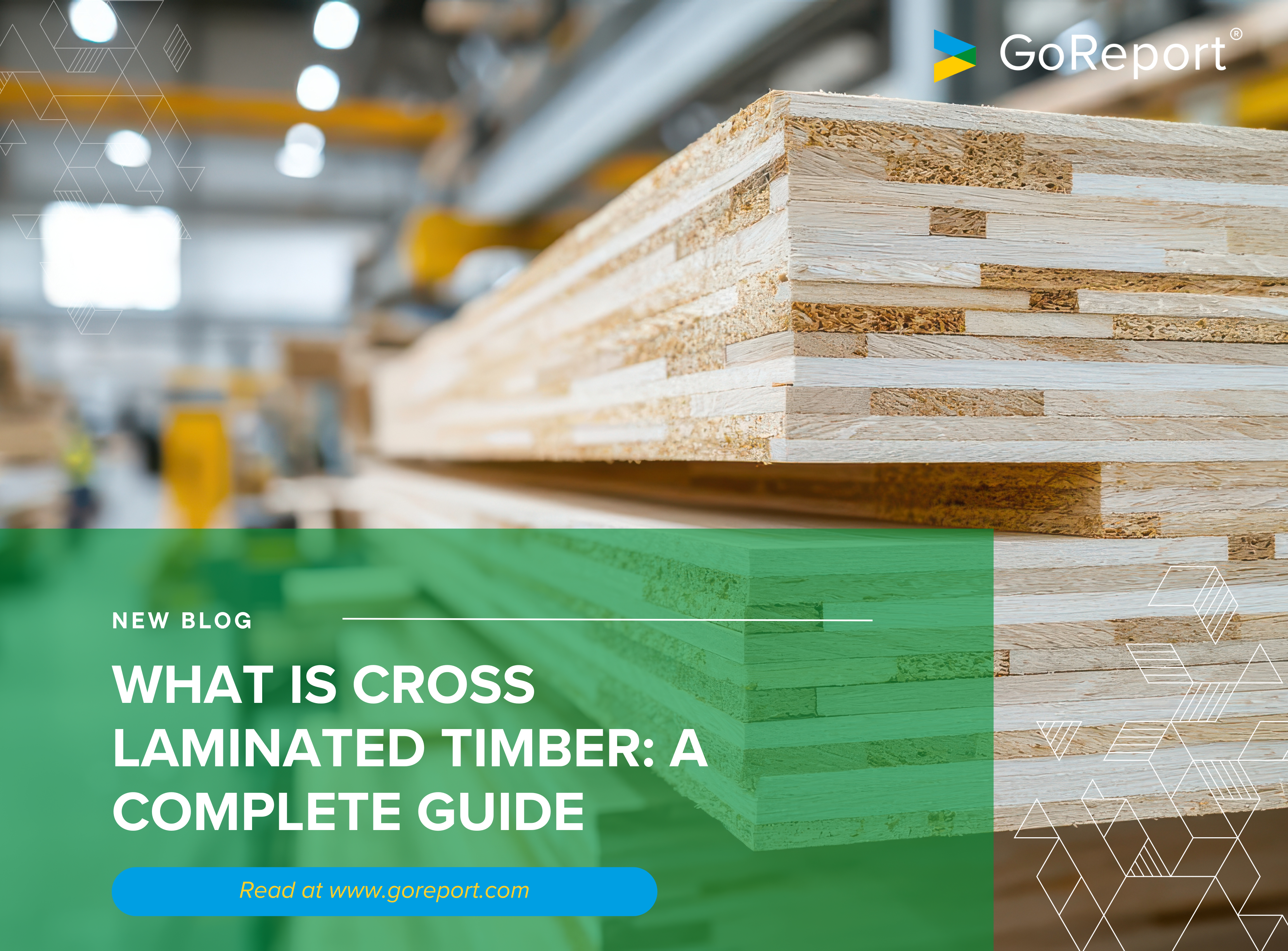What is Cross Laminated Timber: A Complete Guide

If you’re a surveyor, chances are you’ve come across the term Cross Laminated Timber (or CLT, as it’s often abbreviated). Maybe it was during a site visit where a sleek, modern office building was going up, or maybe it came up in a CPD seminar, sandwiched between discussions on sustainability and material innovation.
So…what is cross laminated timber, really? How is it made? And more importantly, why is it turning heads across the construction industry? Let’s break it down properly, in plain terms, with all the technical bits kept practical.
Contexts:
- What Is Cross Laminated Timber?
- How Is Cross Laminated Timber Made?
- CLT vs Traditional Timber: What’s the Difference?
- Benefits of Using Cross Laminated Timber
- Risks and Considerations: What Surveyors Need to Know
- Where Is CLT Being Used in the UK?
- Key Standards and Regulations Around CLT
- How Surveyors Are Involved in CLT Projects
- FAQs About Cross Laminated Timber
What Is Cross Laminated Timber?
Cross Laminated Timber is a mass timber product made by stacking layers of kiln-dried timber boards (typically softwood like spruce) at 90-degree angles to one another, then gluing them together under pressure. CLT panels are typically made in large, prefabricated sections sometimes as big as 3m x 16m, which can be slotted into place on-site like oversized Lego bricks. They form floors, walls, and roofs, all while providing exceptional structural strength. It’s engineered wood that rivals concrete and steel, yet is significantly lighter and much more sustainable.
How Is Cross Laminated Timber Made?
There’s a surprising simplicity to how CLT is made.
- Step 1: Selection and Drying – Boards are sourced from sustainably managed forests and kiln-dried to reduce moisture content (typically 12% ±2%).
- Step 2: Grading and Finger Jointing – Defective boards are rejected. Remaining ones are finger-jointed to form longer laminations.
- Step 3: Layering – The boards are layered perpendicular to each other, usually in three, five, or seven layers.
- Step 4: Bonding – A strong, environmentally friendly adhesive (often PUR or MUF) is applied between layers.
- Step 5: Pressing – Layers are pressed together in a hydraulic or vacuum press, forming a rigid panel.
- Step 6: Cutting and Finishing – Panels are CNC-machined with cut-outs for windows, doors, MEP services, etc.
It’s a fully controlled, factory-based process that offers precision down to the millimetre.
So, why does this matter to surveyors? Factory production means fewer surprises on-site, faster install times, and higher dimensional accuracy, meaning less snagging and rework later
CLT vs Traditional Timber: What’s the Difference?
Feature |
CLT |
Traditional Timber |
Orientation |
Cross-laminated, multi-directional | Single-directional |
Strength |
High strength in both directions | Strong along the grain only |
Size |
Large prefabricated panels | Limited by available lengths |
Uses |
Structural walls, floors, roofs | Mostly framing, non-structural |
Precision |
CNC-cut in factory | Cut and assembled on-site |
CLT panels act more like monolithic slabs than framed assemblies. That opens up design potential while simplifying some aspects of construction, but also demands careful detailing and inspection.
Benefits of Using Cross Laminated Timber
Cross laminated timber is becoming a go-to structural choice for projects where speed, sustainability, and performance matter. While architects might be drawn to its aesthetic, for surveyors and project teams, the real value lies in how it behaves on-site and over time. Whether you’re evaluating options for a multi-storey scheme or advising on carbon impact, understanding what CLT brings to the table is becoming increasingly relevant.
Fast, Clean Construction
When people talk about cross laminated timber, they’re usually not just talking about wood, they’re also talking about what it makes possible. Faster builds. Quieter sites. Buildings that feel better to be in. And yes, buildings that actually look like they belong to this century.
One of the biggest reasons CLT has caught on is speed. It’s cut precisely off-site, down to the millimetre, which means less head-scratching, fewer delays, and almost no site waste. For surveyors, that translates to cleaner logistics, fewer clashes, and faster handovers.
Lightweight but Strong
While we’re talking practicalities, CLT is deceptively strong. Due to the way the timber layers are glued at right angles, the final panel behaves like one solid structural unit. Unlike concrete or steel, it’s light. Not feather-light, obviously, but light enough that you can use it on tricky sites with poor ground conditions or where piling would be excessive. It’s made rooftop extensions possible in buildings that would’ve been ruled out just five years ago.
Low Carbon, High Credibility
There’s also the carbon story. CLT is beyond low-carbon, as it actively stores carbon. The trees that go into each panel have been capturing CO₂ for decades, and the manufacturing process doesn’t undo that. In fact, every cubic metre of CLT can store roughly a tonne of CO₂. For clients chasing down BREEAM scores or local authorities under pressure to hit sustainability targets, that kind of detail suddenly matters.
Naturally Warm and Surprisingly Quiet
Cross laminated timber has excellent thermal properties because, well, it’s timber. It insulates naturally. But what often surprises people is how well it handles acoustics. When designed properly, it can outperform traditional brick and block. That matters in schools, care homes, multi-residential units… anywhere you’ve got people living or working in close proximity. You don’t have to sacrifice peace and quiet to get the carbon savings.
Fire Safety: The Big Question Answered
So, what about fire safety? Fair question. It’s the elephant in the room with any timber structure. CLT doesn’t go up like kindling. The outer layers char, and that charring actually protects the internal structure. It’s been tested to death – literally – and when detailed to code, it can meet EN 13501-1 classifications. Of course, it’s not immune to poor design. But used properly? It performs as predictably as steel or concrete under fire conditions, with the added benefit of being visually warm and tactile.
Risks and Considerations for CLT
However, CLT isn’t a miracle material. Like anything, it has its limits.
Moisture Sensitivity
It’s still timber. Poor detailing can lead to rot or mould, especially around joints or penetrations.
Fire Detailing Is Critical
Charring offers resistance, but exposed surfaces must be planned carefully. Encapsulation strategies vary by project type.
Movement and Creep
Timber shrinks and swells with humidity. You’ll need to factor in dimensional movement in your surveys and reports.
Regulatory Complexity
Post-Grenfell, scrutiny on combustible materials has intensified. Surveyors should stay up-to-date with the latest Building Safety Act guidance.
Pro tip: During inspections, pay special attention to edge seals, moisture barriers, and fixings. They’re often the weak link.
Where Is CLT Being Used?
CLT’s come a long way in the past 15 years, and not just in trendy office builds in London.
- Educational Facilities – Schools and university buildings (notably because of speed and reduced disruption).
- Mid-Rise Housing – Especially Build-to-Rent and social housing sectors.
- Commercial Developments – Offices, co-working spaces, hybrid retail units.
- Healthcare – Faster builds mean less downtime for clinics and surgeries.
And the UK isn’t alone. Austria, Germany, and Scandinavia have long led the charge, but the British market is rapidly catching up.
Key Standards and Regulations Around CLT
If you’re writing reports or checking compliance, you’ll want to be familiar with:
- BS EN 16351 – The main product standard for CLT.
- Eurocode 5 (EN 1995-1-1) – Timber structure design guidelines.
- Approved Document B (ADB) – Fire safety, with updates relevant to timber buildings.
- NHBC Guidance on CLT – Updated recommendations post-2020.
Also, post-Grenfell legislation has tightened how combustible materials are handled, especially in residential towers over 18m.
How Surveyors Are Involved in CLT Projects
Whether you’re involved at feasibility stage or doing snagging near handover, surveyors play a central role in:
- Material suitability assessments
- Moisture ingress inspections
- Fire compartmentation surveys
- Post-installation movement monitoring
- Building lifecycle reporting
Tools like GoReport’s digital data capture platform are helping surveyors carry out more accurate, standardised reporting. If you’re still working from paper checklists, it might be time to see what structured reporting can do for you.
Book a free demo with GoReport here to see how it fits into your timber projects.
FAQs About Cross Laminated Timber
Is CLT allowed in residential buildings over 18m in the UK?
Since the 2018 ban on combustible materials in external walls of high-rise residential buildings, CLT use is restricted in certain contexts. However, workarounds and hybrid systems are being explored.
How long does CLT last?
With proper detailing and maintenance, CLT structures can easily meet or exceed 60-year design lives. Longevity depends heavily on moisture protection.
Is CLT cheaper than steel or concrete?
Initial material costs may be higher, but overall project costs can be lower due to faster build times and fewer trades on site.
Can CLT be used in retrofit projects?
Yes, especially where weight is a constraint, like adding storeys to existing buildings or replacing internal floors.
Does CLT burn easily?
It chars at a predictable rate (around 0.7mm/min), creating a protective layer. Fire safety must be built into the design, not treated as an afterthought.
Tools like GoReport’s digital data capture platform are helping surveyors carry out more accurate, standardised reporting. If you’re still working from paper checklists, it might be time to see what structured reporting can do for you. Book a free demo with GoReport here to see how it fits into your timber projects.







